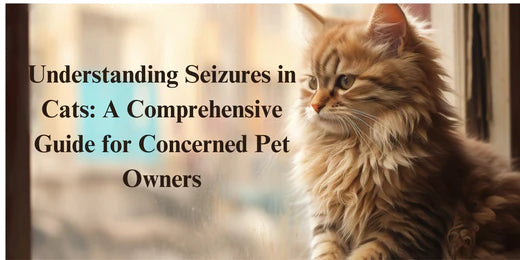
Understanding Seizures in Cats: A Comprehensive Guide for Concerned Pet Owners
Share
Seizures in cats could be stressful for both the pet and the owner. It affects about 1-3% of the cat population. Understanding the causes, types, and treatment options available is important so that your cat gets the best treatment. You need to take quick action and consult your vet if there are any of the symptoms present because, unlike humans, your cat can't ask for help and might face serious repercussions if left untreated. Let's have a look at the classification, causes, and symptoms, as well as the diagnostic techniques and treatment choices available to veterinarians.
Table of Contents
Seizure Classification: Types of Seizures In Cats

Seizures can be classified as generalised, focal, or reflex, with generalised seizures affecting both hemispheres and focal seizures originating from one area of the brain. Reflex seizures are triggered by specific stimuli. We need to discuss the various types of seizures that can occur in cats because it is important to recognise symptoms for proper care.
- Generalised seizures are the most common, affecting the entire brain and leading to loss of consciousness, muscle contractions, and excessive drooling. They last from seconds to a few minutes.
- Focal seizures in cats originate in a specific brain area; these affect only part of the body and may include facial twitching or limb movements, potentially progressing to generalised seizures.
- Reflex seizures are elicited by specific stimuli, with flickering lights being the most prevalent trigger in humans; however, auditory stimuli and the act of eating may also provoke these seizures. Such seizures can manifest as either generalized or focal episodes, frequently accompanied by myoclonic jerks. In felines, a comparable condition known as feline audiogenic reflex seizures has been documented.
A few other uncommon types of seizures are also found in cats, like psychomotor and absence seizures.
- Psychomotor seizures are characterized by unusual behaviors rather than convulsions, such as chasing invisible objects or sudden aggression, making them harder to identify.
- Absence Seizures have brief episodes lasting seconds involving a temporary loss of awareness without convulsions and are less common in cats.
What Causes Seizures In Cats?
Seizures can be classified into extracranial (reactive) and intracranial (structural) origins. Extracranial causes include metabolic disturbances and toxins, while intracranial causes often involve structural brain issues such as tumors, inflammation, or vascular problems.
Common Causes of Seizures in Cats
- Idiopathic epilepsy (IE) is a very rare chronic neurological condition in cats and is diagnosed by exclusion, typically in younger cats (ages 1–5) with normal interictal examinations and recurring seizures. It is important to rule out other causes before diagnosing IE.
- Brain tumors can disrupt normal brain function and cause seizures, particularly in older cats. These tumors can be primary, originating in the brain, or secondary, spreading from other body parts. Common primary brain tumors in cats include meningiomas and gliomas, while secondary tumors often arise from lymphomas or other cancers. It is a common cause of seizures in older cats.
- Central nervous system infections, including bacterial, viral, and fungal types, can result in seizures. Specific infections like toxoplasmosis, feline infectious peritonitis (FIP), and cryptococcosis have been identified as triggers, as they cause inflammation and damage that disrupt normal brain function.
- Metabolic disorders, including hypoglycemia, liver disease, and renal failure, can result in seizures due to imbalances in glucose, toxins, or other metabolic byproducts that affect brain function.
- Exposure to specific toxins, such as pesticides, household chemicals, and certain plants, can trigger seizures by disrupting normal neural activity, as shown in toxicological studies.
- Hydrocephalus is a condition marked by an abnormal accumulation of cerebrospinal fluid (CSF) in the brain, resulting in increased intracranial pressure and seizures. Research indicates that this excess pressure can impair brain function and trigger seizures.
- Unique Causes: Specific conditions such as non-suppurative meningoencephalitis, feline ischaemic encephalopathy, hippocampal necrosis, and thiamine deficiency are seen as unique causes of seizures in cats.
Can Fleas Cause Seizures In Cats?
Though fleas are not a direct cause of seizures, the complications associated with them can contribute to conditions that may result in seizures. It is advisable to consult a veterinarian if a cat infested with fleas exhibits seizure activity. These flea-induced complications include:
- Flea-Borne Diseases: Fleas are capable of transmitting diseases such as Mycoplasma, which can result in anaemia. This condition may manifest neurological symptoms, including seizures.
- Severe Anaemia: Prolonged flea infestations can lead to significant blood loss and subsequent anaemia, potentially diminishing oxygen supply to the brain and precipitating seizures.
- Secondary Infections: The intense itching caused by fleas may result in skin infections, which, if severe, could contribute to conditions that trigger seizures.
- Stress and environmental factors: Chronic discomfort associated with flea infestations can adversely affect a cat's overall health and exacerbate pre-existing conditions that may lead to seizures.
Symptoms Of Seizures In Cats:

Seizures in cats can range from violent convulsions to slight behavioural changes. If your cat suffers the symptoms indicated below, it is crucial to seek veterinary care promptly to ensure their well-being.
Seizures in felines can be distressing to observe. The symptoms may vary; however, common indicators include:
- Uncontrolled Movements: This may manifest as jerking, twitching, or convulsions. One may observe the cat's body becoming stiff or shaking.
- Loss of consciousness: During a seizure, a cat may appear unresponsive or dazed.
- Disorientation: Following the seizure, the cat may exhibit signs of confusion or disorientation.
- Salivation or Foaming: excessive drooling or the presence of foam around the mouth may occur.
- Paddling Movements: The cat's legs may move as if it is running or paddling, despite being in one place or stationary.
- Incontinence: There may be a loss of control over the bladder or bowels during a seizure.
- Vocalisation: Some cats may meow, yowl, or produce other sounds during a seizure.
- Behavioural Changes: After a seizure, a cat may seek hiding places, display unusual aggression, or appear lethargic.
If you notice or think that your cat is experiencing seizures, contact a veterinarian. They can assist in determining the underlying cause and recommend appropriate treatment.
Diagnosis, Treatment, And Management Of Cats With Seizures
A thorough diagnostic evaluation is crucial, including history taking, physical and neurological examinations, laboratory tests, and advanced imaging like MRI.
Treatment for seizures in cats depends on the underlying cause, such as kidney disease, diabetes, or cancer. After a first seizure, veterinarians usually recommend monitoring rather than immediate treatment. For frequent seizures, anti-convulsant medications like phenobarbital, potassium bromide, levetiracetam, or zonisamide are used.
It might require lifelong management and regular blood testing to monitor levels, as some can be toxic. Cats with hypoglycemia or severe illnesses may need hospitalisation and specific treatments, but kittens with hypoglycemic seizures generally recover well with appropriate care.
Conclusion

Caring for a cat with seizures takes patience and regular communication with your veterinarian. With the right care, many cats with seizure disorders can live normal, happy lives. It is critical to regularly monitor your cat's health, take medications as directed, and maintain a seizure diary to chart the frequency, duration, and characteristics of the seizures.
Frequently Asked Questions:
1. What causes seizures in cats?
Seizures in cats are classified as extracranial (reactive) or intracranial (structural). Extracranial causes involve metabolic issues and toxins, while intracranial causes are often due to structural problems like tumours and inflammation. Idiopathic epilepsy is common in younger cats (ages 1–5) after excluding other causes, whereas older cats usually have seizures associated with brain tumours.
2. How to treat seizures in cats?
When it comes to treating seizures in cats, it depends on what's causing them, like kidney issues or diabetes. After a cat has its first seizure, vets usually recommend just keeping an eye on things instead of jumping straight into treatment.
3. What causes focal seizures in cats?
Epileptic seizures originate in the temporal lobe and may trigger focal seizures in cats. These seizures can result in orofacial automatisms such as twitching, lip smacking, salivation, chewing, licking, and swallowing.
